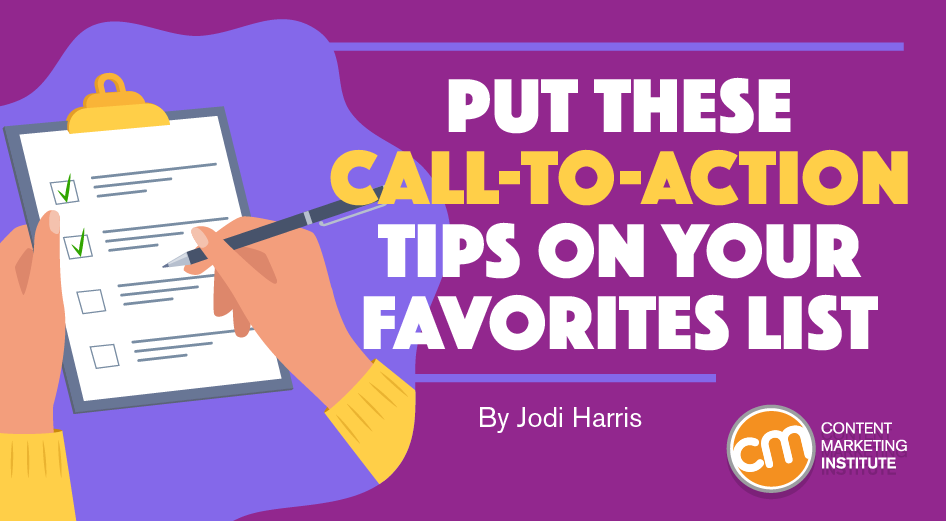
Content can take your brand almost anywhere it wants to go.
But if you want your audience to take steps beyond viewing or reading, you need to show them where to go next. And that means creating a compelling call to action (CTA).
To help you achieve the results you want from your CTAs, I’ve gathered ideas and tips for the strategic fundamentals you’ll need. Review those, then keep reading for tactical tips and examples for making your copy more compelling, layouts more appealing, and campaigns more successful.
Set your audience on the right path with a compelling call to action, says @joderama via @CMIContent @semrush. #ContentMarketing Click To Tweet
Plan your approach strategically
You can’t ask consumers to act until you know what specific action you want them to take – and what might interest them in doing so.
Determine your target goal
Before you write your CTA or plot where and how to place it in your content, you need to decide the goal. Start with the consumer actions that deliver the greatest benefit to your business now.
Focus on the goals your business cares about most, typically one of the ones CMI founder Joe Pulizzi outlined:
- Sales
- ROI
- Decreased costs
- Improved customer loyalty and retention
But revenue-related conversions aren’t the only meaningful actions. You can focus CTAs around content marketing goals, like sending more traffic to your website, increasing downloads of lead-gen content, encouraging viewers to join your communities, or growing a subscribed audience.
Revenue-related CTAs aren’t the only meaningful actions. Think about #ContentMarketing goals, like driving more traffic to your site, increasing downloads, etc., says @joderama via @CMIContent @semrush. Click To Tweet
Make your offers contextually relevant
Take the audience’s context into consideration when planning your CTA and crafting the copy.
For example, imagine a consumer scrolling through their Instagram feed on their phone, and a picture of a trendy outfit from your summer catalog catches their attention. A CTA to visit your e-commerce site for more details about the clothes would be a natural fit, while a CTA to download the catalog might be too much to ask in this setting.
You’ll also want to make sure your CTA aligns well – message, tone, topic, and imagery – with the content it’s connected to. Continuing with the clothing example, a high-quality photo of someone wearing that trendy outfit to a summer BBQ could trigger FOMO (fear of missing out) feelings – and a click to your mobile storefront. Asking them to download a lengthy report on sustainable fabric sourcing practices would be out of place.
Lastly, whenever possible, match your CTA copy to the mindset and intent of your targeted consumers. Remember engaging with a content asset isn’t necessarily a signal that the consumer is looking to make a purchase right now (or at all) – especially for a high-consideration product like a car or an enterprise software solution. So, if you send an email to sales-qualified leads with a CTA for a 25% discount, it might be the perfect catalyst to buy. But if the email goes to everyone in your database, stick to lower-level commitments like downloading a white paper or attending a virtual product demo.
Match your #CTA to the mindset and intent of your targeted consumers, says @joderama via @CMIContent @semrush. Click To Tweet
HANDPICKED RELATED CONTENT:
Communicate clearly, succinctly, and convincingly
Calls-to-action point consumers to attractive offerings that might enhance their trust and satisfaction with your business. But if your CTAs derail their purpose, confuse them, or fail to deliver on the expectations you establish, you risk losing their attention for good.
Follow these creative tips to give your calls to action their best chance of success:
Keep them focused and short
Avoid inserting multiple calls into a single piece of content – there are only so many requests a reader will consider before they lose their focus. Get right to the point with brief, succinct statements that won’t confuse readers. Also, Pawan Deshpande says if you’re using a CTA button, long strings of text won’t have the same positive visual impact as a short one.
Provide clear direction
Beginning your CTA with an active verb – like “Subscribe to our newsletter” or “Download our app” – tells consumers exactly what action you would like them to take, while vague statements like “Learn more” could lead to confusion or disinterest.
Be transparent about what happens next
Will clicking disrupt their content experience by taking them to an off-site page? Will that page contain the information they expect, or will they have to search around for it? Will they get direct access to the download your CTA referenced, or will there be a form? You may not have the space to include every detail of the experience that follows the click, but avoid ambiguity by using words like “register,” “sign up,” or “visit our site” to help set clear expectations.
Select words that set intentions
If your content’s purpose is to drive an immediate conversion, Shane Barker recommends creating a sense of urgency with words like “now,” “instant,” or “today.” If your message is meant to make your customers feel unique or special, he says using words like “custom” or “exclusive” can help convey that they’ll receive VIP treatment.
Use your available space wisely
Shane also points out that if your CTA comes at the end of a blog post or email, outlining your ask in a detailed sentence is acceptable. However, if you’re placing it elsewhere in your content or on a dedicated landing page, he says it’s best to limit the CTA to five to six words.
For social media content, available space and formatting options vary. Get familiar with each channel’s specifications before you publish or critical details may get cut off. Notice how the text gets cut off in the Doodly ad below to read: “Create Doodle Videos With Doodly. Zero Technical or De…”. Confused consumers are less likely to click.

Copy is cut off in Doodly’s CTA, which can confuse customers and make them less likely to click.
Show ’em the money (or other attractive benefits)
Who doesn’t wonder “what’s in it for me” when they see a promo touting a brand’s amazing features and competitive advantages? Focusing your CTA copy on the benefits consumers stand to receive can communicate greater personal relevance – and increase their interest in clicking.
For example, in this sponsored Facebook spot, BuzzSumo smartly syncs up its offer of a helpful content toolkit with a discount-centric CTA to sweeten the deal: “Feeling stuck? BuzzSumo’s all-in-one content toolkit can help generate ideas … Save now with 20% off annual subscriptions.”

BuzzSumo aims to boost subscription purchases with a CTA that offers a 20% discount.
Brain training app Elevate doesn’t offer a discount, but its Instagram post features a checklist of attractive benefits that gives gamers a glimpse of what they might achieve if they install the app: Read faster, write more clearly, and speak with confidence.

Elevate’s checklist of benefits illustrates the value of clicking its CTA.
HANDPICKED RELATED CONTENT:
Perfect your placements
CTAs can’t do their jobs if consumers don’t notice them. So, marketers need to design and position them for optimal findability, appeal, and usability.
Some things to consider:
- Don’t overwhelm your copy. Stuffing a CTA in the middle of short snippets of text, like a collection of curated quotes or a bulleted list, can disrupt the flow of your content, making it hard for readers to follow the story. Among his CTA tips for content curators, Pawan suggests placing calls within longer sections of copy, instead – for example, a detailed explanation of why the quotes you’ve cited are relevant.
- Make them easy to spot and read. The above advice also applies to the visual aspects of your CTAs: They should fit with the accompanying content without getting lost. Think brightly colored buttons that grab attention but don’t stray from your brand’s style guide. Adjust the fonts and colors as necessary for the copy that sits on top of the buttons, so it’s clearly readable against the background.
- Make them mobile-friendly. Mobile devices (excluding tablets) generated 4% of global website traffic in 2021. Your CTAs should follow best practices for mobile-responsive content. Make buttons large enough that visitors won’t accidentally click on the wrong spots, and double-check that your copy doesn’t get cut off on a small screen. Consider using click-to-call features or substitute drop-down selections for detailed forms so mobile users don’t have to type a lot to accept your offer.
HANDPICKED RELATED CONTENT:
ADVERTISEMENT
The State of Content Marketing 2022 Global Report
500K articles analyzed. 1,500 marketers surveyed. 9 experts interviewed. Download the biggest industry report by Semrush and explore thousands of data points to build a better content marketing strategy.
Grab extra attention with unique designs and special features
Speaking of opt-in form alternatives, Treasure Data CMO Tom Treanor shared some formats commonly used to drive subscriptions that can be adapted for other marketing goals. Below are a few of his suggestions for making your CTAs more visible, dynamic, and inviting. (You can find additional ideas in his article on ways to get more opt-ins from your content.)
The pop-up
“The pop-up is one of the most familiar opt-in forms for a good reason,” says Tom. “Even the data scientist of HubSpot found it increases email opt-ins without hurting anything else.”
That lesson can be observed in this pop-up CTA with the message: “Do You To Convert Your Abandoning Visitors Into Subscribers?” followed by yes and no buttons to register for a free 14-day trial.

An example of a CTA formatted as a pop-up from HubSpot.
The pop-up is one of the most familiar opt-in forms and for a good reason. Even the data scientist of @HubSpot found that it increases email opt-ins, says @RtMixMktg via @joderama @CMIContent @semrush. Click To Tweet
The slide-in
Tom says slide-ins create dynamic movement, which can help draw the viewer’s attention. He also reminds marketers that timing your slide-in is important: “You want to catch visitors before they click away.”
He shares an example from AppSumo, which slides into view with an attractive offer of insider knowledge – “Learn exactly how I grew AppSumo to 700,000+ subscribers” –followed by a space to enter an email address and receive that information.

An example of a CTA that slides into view from the side of the screen.
The footer CTA
“Once people have finished reading a great piece of content, they are more likely to consider other offerings from your brand,” says Tom. The footer option capitalizes on this concept. “You can use it with a lead-magnet offer or message that invites people to get similar content by subscribing.”
In this example from Fleet Feet, the footer includes a built-in CTA reading “Join Our Newsletter” with a field to enter an email address.
Use tech and personalization to your advantage
If you’re ready to take your CTAs further, apply some of these more customized approaches. Their benefits range from simplifying the design and implementation process to enhancing personal resonance.
Leverage the power of tech
In a recent post on improving sales enablement content, Ann Smarty recommended a few tech tools that can make CTA customization and implementation easier:
- Vcita lets marketers create customizable and contextual widgets that help ensure that CTAs appear in content where they’re most relevant and appropriate.
- Finteza offers the ability to dynamically serve different CTAs depending on what page the visitor first lands on, the site they were referred from, or prior actions they may have performed on your site. Marketers choose which site pages the modules appear on and the campaign length.
Get up close and personal
You can use CTAs to gather first-party data (an increasingly important goal as privacy regulations limit third-party cookies). For example, Los Angeles-based media site LAist targeted voters with the sponsored Instagram post shown here. While the “Learn more” CTA is standard fare, it’s paired with a political matchmaking quiz to help users determine which of the seven candidates on the primary ballot align most strongly with their views on key issues.

LAist cleverly tempts readers to click the CTA to get personalized election guidance with the copy: “Meet your Mayor – A political matchmaking quiz for LA voters.” The visual catches the eye with circular headshots of each of the seven candidates.
Go beyond the obvious
Shop now, sign-up, register today … spend a few minutes perusing your social feeds and you’ll see a dozen ads using these simple imperatives. You might have a better chance of standing apart and capturing their clicks with an unexpected approach.
For example, cosmetics company Il Makiage is building its brand on a try-before-you-buy model. In keeping with that concept, the company featured a “Watch the transformation” CTA on a recent Instagram post, which clicks through to a video of @realbettymaxwell trying the brand’s makeup.

The CTA in this Il Makiage’s social spot creates intrigue with the promise of an exciting transformation.

Consumers who click through on the Il Makiage CTA see the brand’s products in action.
In her sales-enablement discussion, Ann Smarty offered another unique CTA approach: the in-content form. “It’s designed to feel more like a one-on-one interaction than an institutional form completion,” says Ann.
She shared this example of WordPress plug-in Conversational Forms, which lets visitors answer one question before a new question appears.

A sample of WordPress plug-in Conversational Forms. Image via Wpforms.com.
Stop using institutional field completion forms. A tool like Conversational Forms from @easywpforms lets visitors answer a question before a new question appears, says @SEOSmarty via @joderama @CMIContent @semrush. Click To Tweet
Create CTAs that compel customers to act
Despite their simplicity, effective CTAs involve a lot of strategic and creative decisions. Are you giving your CTAs the attention they deserve? Have any tips we may have missed? Let us know by posting a comment.
All tools mentioned in this article are identified by the author. If you have a tool to suggest, please add it in the comments.
Cover image by Joseph Kalinowski/Content Marketing Institute


![HubSpot's 2025 State of Blogging Report [Data from 500+ Marketers]](https://www.liveseo.com/wp-content/uploads/2025/02/HubSpots-2025-State-of-Blogging-Report-Data-from-500-Marketers.webp-300x300.webp)


